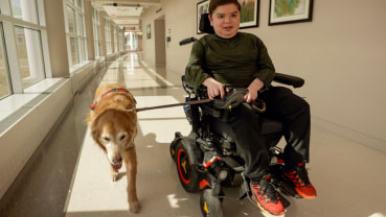Patients at Patricia Kinsella’s medical office are often greeted by her four-legged colleague — a dog in training to become a service animal.
Kinsella, DO, a primary care physician with Rush Copley Medical Group, volunteers with the MidAmerica Service Dogs’ Foundation, a not-for-profit that provides service dogs, free of charge, to children and adults with mobility disabilities.
Her association with the organization began 11 years ago when she was looking for a service opportunity. Today, she serves on the board of directors, reviews applications for the program and interviews applicants to medically determine what assistance they need and whether a dog can help.
She also fosters dogs after they’ve finished training to acclimate them to the community before they are placed with a recipient. And sometimes she helps find the puppies that will become service dogs — dogs that can handle the strenuous work of assisting a person with disabilities.
Providing independence to recipients
“People with mobility disabilities want more independence, and the dogs give them that,” she says.
Recipients rely less on family members as the dogs help with daily activities. A dog can help a recipient get out of bed and into a wheelchair. They help with balance, acting like a cane so the recipient doesn’t need to hold another person’s hand to get around. The dog can retrieve and carry items. One dog gets her recipient ice packs for her headaches, even opening and closing the freezer.
In addition to physical help, the recipients benefit from the loyalty and friendship their service dogs provide. One recipient says that, with her dog at her side, she has confidence when she is out alone. And he gives her unconditional love.
Ryan, now 19 and one of Kinsella’s patients, got his service dog five years ago, two days before he started high school. Ryan has muscular dystrophy, and Duffy assists him by hitting the button to open accessible doors and picking up clothes, trash and other items. When Ryan was in high school, Duffy went to classes with Ryan every day, became a member of the graduating class and had his picture in the school yearbook, right next to Ryan’s. And Duffy has accompanied Ryan to two Super Bowls and Disney World, in addition to a number of Chicago sporting events.
“Duffy became a great friend and companion to Ryan,” says Ryan’s father, Marty. “Duffy made him more popular, especially in high school. Girls love Duffy!”
Preparing dogs for their roles
To become service animals, the dogs receive intensive training beginning when they are eight weeks old. As part of the Illinois Department of Corrections’ Helping Paws Service Dog Training Program, the dogs are trained for a year and a half by female inmates. The dogs learn 100 commands and how to assist people with daily living skills. They learn to pick up objects from the floor, open and close doors, turn lights on and off, assist with dressing and undressing, act as a brace to help a person sit or stand, retrieve items from shelves when shopping and much more.
After a dog has been trained, Kinsella’s role is to expose the dog to different environments and people, including small children. She typically has a dog for four to five weeks and sometimes up to six months.
“The dogs are very well trained, but they’ve been in the same environment,” she explains. She takes them just about everywhere she goes, including the park, grocery store, movie theater, her medical office and even on a boat in Lake Michigan.
This prepares the dogs for all the places they will go when placed with a recipient. One young girl takes her service dog everywhere: to cheerleading, therapy, her school volunteer job, choir, community outings and family fun events.
“The dogs are all trained with the same skill set,” Kinsella says, “but once we evaluate the best potential recipient, we fine-tune the skills for that specific person.”
Kinsella was instrumental in placing Duffy with Ryan, evaluating whether the 14-year-old would benefit from having a dog and if he could handle one. Months before placing the dog with Ryan, Kinsella spent time with him and his family and took Ryan and Duffy to stores to see how they worked together.
“Ryan and Duffy took to each other immediately,” Marty recalls. “Now they’re best friends.”
After a dog is placed with a recipient, the foundation routinely checks on the pair to ensure the dog is healthy and being used appropriately. The foundation provides continual training as long as the recipient has the service dog, with weekly meetings for the recipients and dogs to attend. When a dog ages out of service, it remains with the individual as a pet, and a younger dog is brought in to work.
Rewarding work
While Kinsella’s fostering role is to help the dog acclimate to others, she finds that having a dog at her medical office helps put her patients at ease.
“Patients are much more comfortable with a dog there,” she says. “It makes difficult conversations much easier.”
Kinsella also derives personal satisfaction from her volunteer role.
“I have made many long-lasting connections with amazing people I would not otherwise have encountered,” she says, “and it has been very rewarding to work with the prison program watching the transformation in some of the inmates. Seeing the recipients weekly really helps me keep day-to-day issues in perspective.”
Marty speaks highly of Kinsella and the MidAmerica Service Dogs Foundation.
“It’s a wonderful organization,” he says. “The volunteers do this out of the goodness of their hearts. They’ve helped a lot of people over the years, of all ages and all disabilities.”
Proud to be part of an organization that is about “changing people’s lives four paws at a time,” Kinsella sees firsthand how the dogs give these individuals the courage to go places and do things they would not otherwise be able to do.
“This program is all about helping people,” Kinsella says. “It’s absolutely amazing.”




